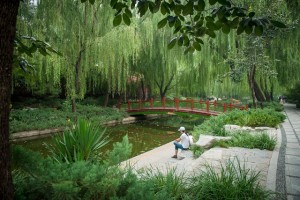Green Spaces: Saving You Money and the Planet
By: Kat KrovetzWant to lower your energy bill? How about reduce your CO2 emissions? If you live in a city, all you need to do is plant a tree to help counteract the problems resulting from urban heat islands.
An urban heat island is a city in which there is an unnaturally warm ambient temperature. This is created because surfaces commonly found in cities, such as concrete and asphalt, are very absorbent of the sun’s heat. Urban heat islands increase electricity use through an increased need for air conditioning. An increase need for air conditioning mean higher energy bills. And higher energy use means more energy must be produced. This causes more fossil fuels to be burned and more CO2 to be released, which contributes to global warming. So even is this seems like a city problem, urban heat islands could concern everyone.
How can we combat this problem? A new study was recently conducted in Beijing, China on the effects of green spaces on urban heat islands. Green spaces are areas of plants, like trees, grasses, or shrubs, in an otherwise urban area. These green spaces can be larger areas, such as parks, or smaller areas, like your backyard.
 A Green Space in Beijing
A Green Space in Beijing
Source: Davis, Ben. 2012. Ben Davis Photography, Beijing.
The study examined two ways in which green spaces help lessen the effects of urban heat islands. Firstly, and most simply, trees provide shade. This means that the sun’s rays never reach the ground to be absorbed. Secondly, plants cool the air via a process called evapotranspiration. Evapotranspiration is the combination of evaporation, water moving from the ground to the atmosphere, and transpiration,water moving from plants to the atmosphere. Transpiration cools the air because energy is used for the movement of water, instead of warming the air. (Zhang, 2014)
The study divided the green spaces into five different categories to be examined, based on the type of vegetation in that area. The categories were areas with just trees, just grasses, just trees and shrubs, or just shrubs and grasses, or any combination of trees and grasses and shrubs. They found that the most effective means of lowering the temperature in urban heat islands is through the use of green space with trees, grasses, and shrubs together. These areas could reduce the temperature of the surrounding area by over 8oF! (Zhang, 2014)
The study highly encourages city planners to put more green spaces in when designing city areas to lessen the effects of urban heat islands. The effects of shading and evapotranspiration combined reducedthe cooling costs of the city’s citizens by 60%, leading to CO2 emissions being reduced by a whopping 243,000 tons! (Zhang, 2014)
So appreciate your city parks, they are saving you a ton on air conditioning and are helping to stop global warming.
Works Cited:
Read More:
Urban Heat Islands Cause Pests
“Heat Islands” Cook U.S. Cities Faster Than Ever